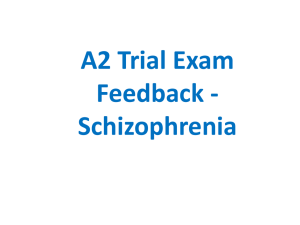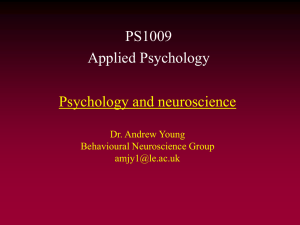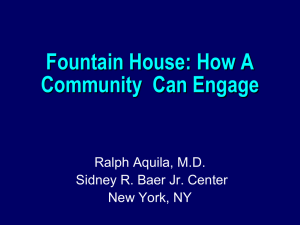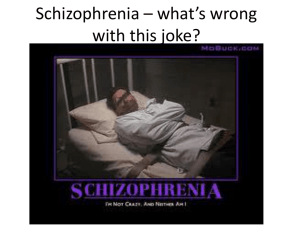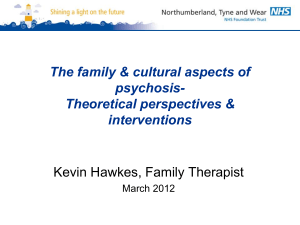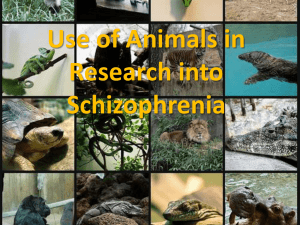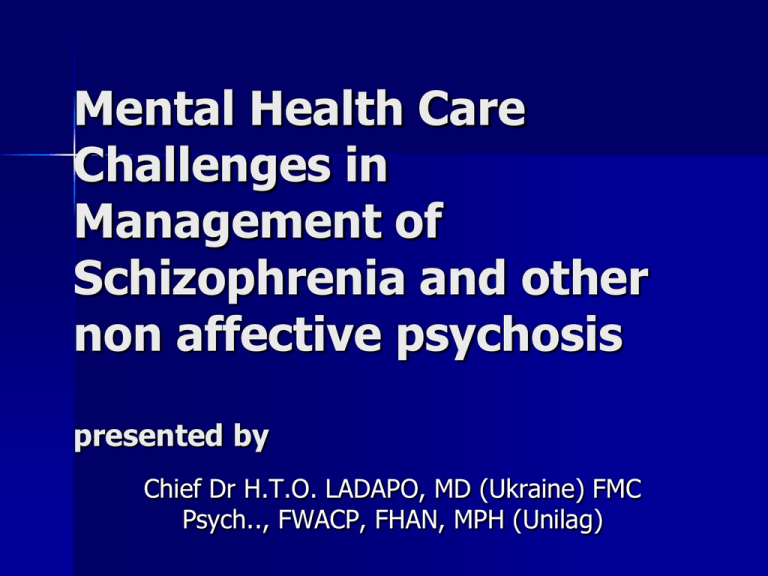
Mental Health Care
Challenges in
Management of
Schizophrenia and other
non affective psychosis
presented by
Chief Dr H.T.O. LADAPO, MD (Ukraine) FMC
Psych.., FWACP, FHAN, MPH (Unilag)
Introduction (1)
Early Greek physicians described
delusions of grandeur, paranoia, and
deterioration in cognitive functions and
personality.
Schizophrenia did not emerge as a
medical condition worthy of study and
treatment until the eighteenth century.
Intoduction (2)
Emil Kraepelin delineated insanity:
manic-depressive psychosis and
dementia praecox (or dementia of the
young)
In 1911 Eugen Bleuler suggested the
term schizophrenia (splitting of the
mind) for the disorder.
Intoduction (3)
He also described four primary
symptoms (the four As): abnormal
associations, autistic behavior and
thinking, abnormal affect, and
ambivalence.
Intoduction (4)
Nondisease models:
-The societal reaction theory ("a sane
reaction to an insane world")
-Thomas Szasz's theory which states
that schizophrenia is a myth enabling
society to manage deviant behavior
Epidemiology (1)
Schizophrenia is a leading public
health problem that exacts enormous
personal and economic costs
worldwide.
Schizophrenia affects just under 1
percent of the world's population
(approximately 0.85 percent).
Epidemiology (2)
NIMH’s Epidemiologic Catchment Area
(ECA) study – lifetime prevalence
1.5%
International Pilot Study of
schizophrenia (IPSS)
Determinant of Outcome studies by
WHO (12 countries)
Epidemiology (3)
A 1987 review of over 70 prevalence
studies of schizophrenia published
since 1948 identified point prevalence
in various population groups ranging
from 0.06 percent to 1.7 percent, with
lower rates in developing countries.
Epidemiology (4)
Life time risk ranges from 0.7% to
1.3%
The prevalence rate is similar in
different cultures when assessed using
similar instrument ( Jablensky et al
1992)
Exceptions include Slovenia, Western
Ireland, Catholics in Canada and
Tamils of Southern India
Epidemiology (5)
Low rates have been reported in the
Hutterrites and the Anabaptist sects in
the USA
Onset usually between the ages of 15
and 45
Peak age in men 15 - 25years
Peak age in women 25 – 35 years
Risk factors
Genetic Factors
Ethnicity and Racial Factors
Age
Sex
Season and Birth Order
Birth and Fetal Complications
Social Class: ”downward drift” and
“social causation” theories
Risk factors
Marital Status
Immigration
Urbanization and Industrialization
Life Stressors
Infections
Suicide Risk
Aetilogy (1)
Cause is unknown
Results from a complex interplay of
genetic, environmental and social
factors
Aetiology (2)
Neurobiological model
Structural abnormalities include:
enlarged lateral ventricles
enlarged third ventricle, and
reduced volume of a number of
structures, including hippocampus,
amygdala, and frontal and temporal
cortices.
Aetiology (3)
Genetic factors
Family studies
Twin studies
Adoption studies
Population
Prevalence (%)
Gen pop.
1.0
Non twin sibling
8.0
Child with one parent with schizophrenia
12.0
Dizygotic twin of schizophrenia patient
12.0
Child of two parents with schizophrenia
Monozygotic twin of a schizophrenia patient
40.0
47
Aetiology (4)
Genetic factors
Putative schizophrenia susceptibility
loci yielding some evidence of
confirmation include loci on
chromosomes 6, 8, and 22.
Aetiology (5)
Neurobiology
blood flow to several brain regions,
including prefrontal and temporal
areas, is altered in schizophrenia.
These changes may be related to or
may underlie positive and negative
symptoms as well as some cognitive
deficits.
Aetiology (6)
Neurobiology
Biochemical basis of schizophrenia
Dopamine
Serotonin
glutamate
Aetiology (7)
Dopamine hypothesis:
It postulates a hyperactivity of
dopamine transmission at the D2
receptors in the mensecephalic
projection to the limbic striatum
(Synder et al. 1974)
Aetiology (8)
Evidence in support of dopamine hyp.
There is a tight correlation between
the therapeutic doses of conventional
antipsychotic drugs and their affinities
for D2 receptors (Seeman, 1987)
Indirect dopamine agonists can
induced psychosis in healthy subjects
and at very low doses provoke
psychotic symptoms in schizophrenia
(Carlsson 1988)
Postmortem and PET studies have
shown increased dopamine D2
receptor level in the brain of
schizophrenic patients (Wing et al,
1986)
There is also emerging evidence for a
presynaptic dopaminergic abnormality
in schizophrenia (Laruelle et al 1999).
Existing literature suggested heritable
abnormalities of prefrontal dopamine
function are prominent features of
schizophrenia (Egan et al, 2001)
Serotonin
Serotonin receptors are involved in the
psychotomimetic and psychotogenic
properties of hallucinogens [e.g
(LSD)];
the number of cortical 5-HT 2A and 5HT 1A receptors is altered in
schizophrenic brains;
5-HT 2A and 5-HT 1A receptors play a
role in the therapeutic and/or side
effect profiles of atypical
antipsychotics (e.g., Clozapine);
certain polymorphisms of the 5-HT 2A
receptor gene are associated with
schizophrenia;
the trophic role of serotonin in
neurodevelopment may be usurped in
schizophrenia;
5-HT 2A receptor-mediated activation
of the prefrontal cortex may be
impaired in some schizophrenics;
serotoninergic and dopaminergic
systems are interdependent and may
be simultaneously affected in
schizophrenia (Liebermann et al. 1998,
Harrison 1999).
Glutamate
Potent non-competitive antagonist of
the NMDA subtype of glutamate
receptor (NMDA-R), induce
schizophrenia-like symptoms in
healthy individuals and worsen some
symptoms in Schizophrenia (Hirayasu
et al. 2001; Andreasen 1997).
Postmortem studies of schizophrenic
brains additionally indicate
abnormalities in pre and postsynaptic
glutamatergic indices.
NMDA-R hypofunction in the cortical
association pathways could be
responsible for a variety of cognitive
and other negative symptoms
(Carlsson et al 2000).
It has been proposed that NMDA-R
antagonist can cause excess
compensatory release of glutamate
that can over activate unoccupied nonNMDA glutamate receptors. This might
in part be responsible for their
behavioural effects.
The effects of inhibiting NMDA-R may
manifest through dopamine
neurotransmission as dopamine and
glutamate systems in the central
nervous system have both anatomical
and functional inter relationship.
Finally, NMDA-R hypo function may
also produce abnormalities in the
neuroplasticity of neurons by altering
synaptic connectivity.
Aetiology (9)
Neurodevelopmental hypothesis:
posits that insults occuring in-utero or
shortly after birth are responsible for
the structural abnormalities which
manifest in symptoms later in
adolescence/adulthood
Evidence in support includes
Absence of gliosis despite evidence of
neuronal loss
Evidence of impaired maturation,
migration and pruning of neurons in
schizophrenic brains
Cytoarchitectural abnormalities in
medial temporal lobe
Aetiology (10)
Environmental factors:
maternal bonding
early rearing
Poverty
immigration status
Stress
viruses.
Aetiology (11)
Social factors
Culture
Migration
Residence
Social isolation
Occupation and social class
Aetiology (12)
Psychosocial stresses:
experiencing life event in the
preceding six months doubles the risk
of developing schizophrenia (Paykel
1978)
There is however, no evidence that
schizophrenics experience more life
events than the general population
Aetiology (13)
Family
Deviant role relationship:
“schizophrenogenic mother”
Lidzs & Lidzs (1948) described marital
schism and marital skew
Bateston et al, 1956 described
Disorder family communications
(Double bind theory)
Aetiology (14)
Psychodynamic factors
Mainly of historical interest
Freud's theory of schizophrenia
Melanie Klein’s theory
CLINCAL FEATURES
DIAGNOSTIC CRITERIA
Schneider
Langfelt
New Haven Schizophrenia Index
St. Louis Criteria
Research diagnostic Criteria
Present State Examination (PSE)
ICD-10
DSM
Positive vs. Negative symptoms
SCHNEIDERIAN FIRST RANK SYMPTOMS
a) Audible thoughts
b) Voices arguing or discussing or both
c) Voices commenting
d) Somatic passivity experiences
e) Thought withdrawal and other
experiences of influenced thought
f) Thought broadcasting
g) Delusional perceptions
h) All other experiences involving
volition, made affects, and made
impulses
Second rank symptoms
a) Other disorders of perception
b) Sudden delusional ideas
c) Perplexity
d) Depressive and euphoric mood
changes
e) Feelings of emotional impoverishment
f) “And several others as well”
DSM IV and ICD 10
Types
Type I schizophrenia was
characterized by predominantly
positive symptoms, good premorbid
functioning, sudden onset, normal
brain structures by computed
tomography (CT), good response to
treatment, and a better long-term
course.
Type II schizophrenia was
characterized mainly by negative
symptoms, an insidious onset, poor
premorbid functioning, abnormalities
on CT scans, a tendency to drug
resistance, and a poorer long-term
course and outcome, often resulting in
behavioral deterioration. (Tim Crow)
Other types
Paranoid
Hebephrenic/disorganised
Catatonic
Simple
Residual
undifferentiated
TREATMENT
Pharmacotherapy
Psychosocial intervention
Factors Influencing Antipsychotic
Drug Selection
Factors
Considerations
Subjective response
A dyphoric subjective response to a particular
drug predicts poor compliance with that drug
Sensitivity to extrapyrimidal
adverse effects
A serotonin-dopamine antagonist (SDA)
Tardive dyskinesia
Clozapine or (possibly another SDA)
Poor medication compliance
or high risk of relapse
Injectable form of a long-acting antagonist
Haloperidol or fluphenazine)
Pregnancy
Probably haloperidol (most data supporting its
safety)
Cognitive symptoms
Possibly an SDA
Negative symptoms
Possibly an SDA
Psychosocial intervention
Individual psychotherapy
Group therapy
Family Therapy
Psychiatric Rehabilitation
Social Skills Training
Vocational Rehabilitation
Residential Treatment And Housing
Programs
Features Weighing Toward Good to Poor Prognosis in Schizophrenia
Good Prognosis
Poor Prognosis
Late onset
Young onset
Obvious precipitating factors
No precipitating factors
Acute onset
Insidious onset
Good premorbid social, sexual,
Poor premorbid social, sexual,
and
work histories
and work histories
Mood disorder symptoms
Withdrawn, autistic behavior
(especially depressive disorders)
Married
Single, divorced, or widowed
Family history of mood disorders Family history of schizophrenia
Good support systems
Poor support systems
Positive symptoms
Negative symptoms
Other features of poor
prognosis
Neurological signs and symptoms
History of perinatal trauma
No remissions in 3 years
Many relapses
History of assaultiveness
Other psychotic Disorders
Delusional Disorders
Schizophreniform Psychosis
Reactive Psychosis
Schizo-Affective
Atypical-Folie a Deaux, culture bound
syndrome, Capgras,Cotard,Fregoli
Schizotypal personality disorder
Postpartum psychosis
Recent advances
Team working in LMU
Found rare genetic variations that
have a major influence, but also found
frequent genetic variations that have
only a minor effect on the disease
risk.“
identify three so-called
microdeletions.”
Challenges Of Management
Of Psychiatric Disorders
Available service not centralized but
concentrated only in the cities within the
country.
Non inclusion of services in National health
Insurance Scheme.
Problem of stigma and negative perception
of mentally ill patients
Challenges of religious doctrines leading to
mis management and chronicity.
Atypical drugs though available has given
hope for treatment of resistant and chronic
condition thereby reducing chronicity.
- cost of drugs is on the high side, many
could not afford to purchase.
- Infiltration of fake and genuine drugs in
drug market.
- Need for government subsidy of drugs to
reduced burden of family and community.
Iloperidone, also known as Fanapta,
and previously known as Zomaril, is an
investigational atypical antipsychotic. It
is being investigated mainly for the
treatment of schizophrenia symptoms.
THANK
YOU FOR
LISTENING


